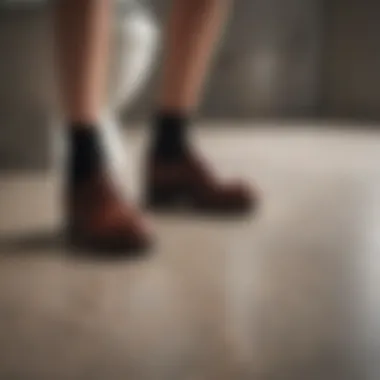Mastering Clogged Toilets: Essential Unclogging Guide


Intro
A clogged toilet can present a major inconvenience. Homeowners often feel stress when faced with this common plumbing issue. Recognizing the significance of dealing with a clogged toilet is crucial. It entails more than a minor annoyance; if left untreated, it can lead to water damage and hygiene concerns.
In this article, we will explore the essential steps to troubleshoot and resolve a clogged toilet. From identifying common causes to using specific tools and methods, the information provided will empower readers. Moreover, prevention strategies will be discussed to avoid future clogs.
By understanding how to address a clogged toilet, individuals can feel more confident in managing home maintenance tasks. This guide aims to provide practical solutions and insights, ensuring that readers no longer feel helpless in the face of plumbing challenges.
Prologue to Clogged Toilets
A clogged toilet is a plumbing issue that many homeowners encounter at some point. It is not merely a nuisance; it can lead to a significant disruption in daily activities and, if left unresolved, can cause further complications. Understanding how to manage this problem is essential for maintaining a functional home.
Addressing a clogged toilet is important for several reasons. First, it affects hygiene and sanitation. A non-functional toilet can lead to unsanitary conditions, creating health risks for everyone in the household. Second, resolving a clog promptly can save time and money. If you can troubleshoot and fix the issue yourself, you can avoid the potentially high costs of hiring a plumber.
Being knowledgeable about common clog causes and procedures to remedy them empowers individuals in their home maintenance efforts. This proactive awareness is necessary not just for immediate solutions but for understanding the bigger picture. It includes recognizing when a clog may hint at more severe plumbing issues.
The context of this guide enables readers to navigate the technicalities of plumbing with confidence. By articulating the steps necessary to address clogs, this article fosters an empowering dialogue about home maintenance.
In brief, tackling a clogged toilet is not just about fixing an inconvenience. It is about ensuring that your home remains a well-functioning space, vital for your comfort and well-being.
Understanding the Causes of Toilet Clogs
Understanding the causes of toilet clogs is essential for anyone interested in home maintenance. Knowing why a toilet becomes clogged can lead to more effective prevention and solutions. Toilet clogs can stem from various issues, and recognizing these can save time and stress down the line.
Common Obstructions
Many common obstructions lead to toilet clogs. These include:
- Excessive Toilet Paper: Flushing large amounts of toilet paper can overwhelm the plumbing system. Unlike other waste, toilet paper does not disintegrate as quickly in water, leading to blockages.
- Foreign Objects: Items such as toys, feminine hygiene products, and paper towels can easily get lodged in the toilet. Many homes have kids, and they sometimes flush inappropriate items out of curiosity.
- Waste Build-up: Over time, mineral deposits and waste can build up in the pipes, resulting in narrow passageways. Once the flow is limited, even small amounts of waste can cause clogs.
Structural Pipe Issues
Structural pipe problems can also contribute to toilet clogs but are often overlooked. These issues can include:
- Bends in Pipes: If pipes have bends or traps due to poor installation or design, waste can accumulate in these areas and cause clogs.
- Tree Root Infiltration: In older homes, tree roots may have grown into or around sewer lines. This can obstruct waste flow and create significant clogs.
- Pipe Corrosion: Rusty or corroded pipes can develop irregular surfaces that trap waste and hinder drainage. This issue can become serious if left unaddressed.
Identifying the cause of a clog is the first step toward resolving the problem effectively. Understanding both common obstructions and structural issues can lead to better management of toilet maintenance.
Immediate Steps to Take When a Toilet is Clogged
Addressing a clogged toilet requires immediate action. Understanding the right steps can prevent further complications. When faced with this situation, maintaining composure is vital to minimize panic and approach the issue effectively. Taking quick and informed measures can save time and avoid unnecessary stress.
Stay Calm and Assess the Situation
The first step in tackling a clogged toilet is to remain calm. Panic can lead to poor decision-making and exacerbate the problem. Take a moment to assess the immediate surroundings. Consider how long the toilet has been clogged and if there are any visible signs of overflow or potential leaks.
Here are some key considerations during this assessment:
- Check for overflow: Is the water level rising? Look for potential leaks around the base of the toilet.
- Identify possible causes: Think about what might have caused the blockage. Are there objects that could have fallen into the toilet?
- Gather necessary tools: Before taking any more action, make sure you have access to essential tools like a plunger or toilet auger if needed. These preparations can streamline the unclogging process.
By taking a moment to evaluate the situation, you equip yourself with the necessary information to proceed effectively.
Avoid Flushing Again
Another crucial action to take when dealing with a clogged toilet is to refrain from flushing again. Flushing a clogged toilet can lead to overflows, causing more mess and potential damage. This action may seem instinctive for some, but it is important to resist the urge.
Here are some reasons to hold off on flushing:


- Preventing Overflows: If the toilet is already clogged, additional flushing may cause it to overflow, flooding the bathroom floor.
- Increased Difficulty: Flushing repeatedly can push down the obstruction deeper, making it more challenging to dislodge.
- Wasting Water: Each flush uses water, which can be wasted if the toilet is not cleared quickly.
Basic Tools Needed for Unclogging Toilets
When faced with a clogged toilet, the right tools can make all the difference in swiftly resolving the issue. This section examines the essential instruments one needs to effectively tackle toilet clogs. Understanding each tool’s function will contribute to a more efficient unclogging process, ensuring that a minor inconvenience does not escalate into a more significant plumbing crisis.
Plunger: The Essential Tool
A plunger is perhaps the most recognized tool for unclogging toilets. Its design is straightforward yet remarkably effective. The rubber suction cup creates a seal against the toilet's outlet. This allows for a powerful push-and-pull motion that can dislodge most blockages. Choosing the right plunger is vital; a flange plunger, specifically designed for toilet use, is preferable over a cup plunger, which is generally better suited for sinks.
Here are some key benefits of using a plunger:
- Versatility: Ideal for various types of clogs.
- Immediate Action: Can often clear blockages without delay.
- Cost-Effective: Generally inexpensive and widely available.
Before using a plunger, ensure that there is enough water in the bowl to cover the suction cup. Without water, the plunger cannot create the necessary seal, making it less effective.
Toilet Auger: When to Use
In cases where a plunger fails to resolve the issue, a toilet auger becomes the next step. This tool is especially useful for deeper clogs located further down the plumbing system. A toilet auger consists of a long, flexible steel wire with a crank handle. As the user cranks the handle, the wire extends into the toilet's drain, allowing it to break up stubborn clogs or retrieve objects lodged in the pipes.
You should consider using a toilet auger when:
- The toilet repeatedly clogs.
- There is an obvious obstruction beyond the reach of a plunger.
- Liquid drain cleaners have failed to resolve the issue.
"Using a toilet auger requires caution - improper use can damage the toilet’s internal parts."
Other Useful Tools
While the plunger and toilet auger are the primary tools for unclogging toilets, several other items can assist in this arduous but necessary task. These tools include:
- Rubber Gloves: Protecting hands from germs and potential harm during the unclogging process.
- Baking Soda and Vinegar: An eco-friendly alternative for minor clogs. The chemical reaction can help break down blockages without harsh chemicals.
- Wet/Dry Vacuum: Can extract significant amounts of water from the toilet bowl and potentially remove obstructions.
- Flashlight: Helpful for inspecting the toilet's interior and pipes, particularly if a foreign object might be causing the blockage.
Having a well-stocked toolkit for unclogging toilets not only equips you for currently blocked situations but also prepares you for any future plumbing challenges, enhancing your confidence in handling home maintenance tasks.
Using a Plunger Effectively
When dealing with a clogged toilet, knowing how to use a plunger effectively can make a significant difference in the outcome. Using a plunger is often the first step for homeowners facing this common issue. This tool, when used correctly, can clear most blockages without the need for harsh chemicals or professional help. Understanding its importance means you are more prepared to handle problems when they arise, saving both time and stress.
Choosing the Right Plunger
Not all plungers are created equal. The effectiveness of your efforts can depend largely on the type of plunger you select. The best choice for a toilet is a flange plunger. This design has a singular cup with an extended flange at the bottom. The flange fits snugly into the toilet drain, creating a better seal than a standard cup plunger, which is typically used for sinks.
- Flange Plunger Features:
- Common Mistakes:
- Cup Design: Designed to fit well into toilet bowls.
- Flange: Ensures a better seal, increases suction.
- Using a sink plunger instead of a toilet plunger.
- Not checking the condition of your plunger. A damaged cup can decrease effectiveness.
Selecting the right plunger is crucial for successful unclogging. Without the proper tool, you may find yourself frustrated and your toilet still blocked.
Technique for Effective Use
Once you have chosen the right plunger, it’s important to employ the correct technique to maximize your chances of success. Here are several steps to follow, ensuring you use the tool effectively:
- Position the Plunger: Place the plunger directly over the drain hole. Ensure the flange is inserted into the opening. This will create a seal.
- Push Down Gently: Begin with a gentle push to get a feel for the resistance. If you push too hard too quickly, you risk splashing.
- Vigorous Up and Down Motion: After the initial push, use a firm up-and-down motion. Maintain the seal, alternating between pushing down and pulling up.
- Keep Going: Continue for about 15 to 20 seconds. If you notice water beginning to drain, you may be making progress.
- Remove the Plunger: Lift the plunger away to see if the water drains. If it does, congratulations! If not, repeat the process.
Effective plunging requires patience. It might take a few tries before the clog is cleared.


Following this technique will create the necessary suction and pressure to dislodge most clogs and restore normal function to your toilet. By employing the right tool and technique, you are empowered to tackle one of the most common household issues.
Employing a Toilet Auger
When faced with a stubborn clog in your toilet, a toilet auger can be an invaluable tool in your unclogging arsenal. Unlike a plunger, which primarily provides suction, a toilet auger is designed to reach deep into the toilet's trap and pipe system. This allows it to break free clogs that are otherwise unreachable. Understanding when and how to utilize a toilet auger can significantly enhance the effectiveness of your plumbing maintenance efforts.
When to Utilize a Toilet Auger
Recognizing the right moment to use a toilet auger can save both time and frustration. You should consider employing a toilet auger under the following circumstances:
- Persistent Clogs: If repeated plunging has failed to resolve the blockage, a toilet auger can reach into the drain and penetrate deeper than the plunger.
- Types of Clogs: Clogs caused by foreign objects, excessive toilet paper or other dense materials often require a more forceful approach than what a plunger can offer.
- Long-Distance Obstacles: If the clog is located further down the plumbing system, an auger can navigate through bends and turns, offering better access.
Using a toilet auger appropriately ensures that you tackle not just surface-level issues, but deeper plumbing concerns that could lead to more significant problems if left unresolved.
Step-by-Step Usage Instructions
Using a toilet auger effectively involves a few simple steps. Following these instructions will help in achieving the best results:
- Prepare the Area:
- Insert the Auger:
- Use the Crank:
- Push and Retrieve:
- Flush the Toilet:
- Clean the Auger:
- Lay down towels or newspaper around the base of the toilet to catch any spills from the auger.
- Position the toilet auger so that the head goes into the toilet bowl. Slowly and carefully feed the auger’s flexible cable into the toilet drain until you encounter resistance.
- Begin to rotate the handle on the auger. This action allows the auger tip to engage with the blockage more effectively, breaking it up or pulling it out.
- If you feel the auger has broken the clog, gently pull it back while continuing to crank. This will help to dislodge remaining debris.
- After using the auger, flush the toilet to check if the water drains properly. If it does, you have successfully cleared the blockage.
- After successfully unclogging, clean the auger according to the manufacturer's instructions to maintain its effectiveness for future use.
Employing a toilet auger can seem daunting at first, but following these straightforward steps will ensure effective use. With practice, you will gain confidence, allowing you to address toilet clogs swiftly and efficiently.
"Having the right tools for plumbing issues not only saves time but also provides peace of mind knowing you are prepared for common household challenges."
Chemical Drain Cleaners: Pros and Cons
Chemical drain cleaners are common products that many individuals turn to when faced with a clogged toilet. Understanding their advantages and disadvantages is essential for effective decision-making in home maintenance. This section explores these aspects in order to give you a clearer picture of whether using chemical drain cleaners is the right choice for your plumbing issues.
Alternatives to Mechanical Methods
Before opting for chemical solutions, it is wise to consider mechanical methods for unclogging toilets. These methods, such as using a plunger or a toilet auger, are often more effective for minor clogs without exposing your plumbing to harsh substances.
Here are some alternatives you might explore:
- Plunger: Most reliable for immediate clogs. The suction created can break up the blockage effectively.
- Toilet Auger: Useful for more stubborn or deeper clogs. It features a flexible cable that can reach into the pipes.
- Wet/Dry Vacuum: If you have access to a wet/dry vacuum, this can also be a practical option. It can remove water and debris without chemicals.
While chemical drain cleaners can break down clogs caused by organic materials, they may not work well with solid obstructions, such as toys or excessive toilet paper. Always assess the situation and consider mechanical methods before reaching for chemical solutions.
Environmental Considerations
When choosing to use a chemical drain cleaner, one must also consider the environmental impact. Many of these products contain toxic substances that can harm aquatic life and even contaminate water supplies.
Key points to keep in mind regarding environmental considerations include:
- Toxic Ingredients: Many chemical cleaners, such as sodium hydroxide and sulfuric acid, can be hazardous. Prolonged exposure can lead to health risks for individuals and pets.
- Water Pollution: If these chemicals enter the water system, they can harm ecosystems and wildlife, disrupting delicate biological processes.
- Alternatives: Non-toxic or biodegradable alternatives are available that can address clogs without the environmental risks associated with harsh chemicals.


"While chemical drain cleaners can be effective temporarily, their long-term consequences on both plumbing and the environment should be seriously considered."
Understanding the pros and cons of chemical drain cleaners can play a crucial role in your plumbing maintenance strategy. By weighing these against mechanical options and environmental factors, you can make informed decisions that best suit your household needs.
Preventative Measures to Avoid Clogs
The significance of preventative measures in maintaining the functionality of a toilet cannot be overstated. Clogged toilets not only disrupt daily routines but can also lead to expensive repairs and water damage. By adopting a proactive approach, homeowners can avoid the inconvenience and potential hazards associated with toilet clogs. Preventative measures involve a combination of education, awareness, and consistent maintenance practices that can significantly reduce the risk of clogs.
Educating Household Members
One of the first steps in preventing toilet clogs is educating all household members about what can and cannot be flushed. Knowledge is key to avoiding mishaps. It is essential to clarify that only human waste and toilet paper should be disposed of in the toilet. Other items, such as feminine hygiene products, wipes, and excessive amounts of toilet paper, should be thrown in the trash.
- Conduct an informative session: Take the time to explain the plumbing system and the consequences of clogging it. Make it clear that non-flushable items can lead to severe blockages.
- Post visual reminders: Consider placing a note on the bathroom wall to remind everyone of the proper disposal rules. This serves as a constant reminder to think before they flush.
By fostering an understanding of toilet maintenance among household members, you create a culture of awareness that greatly minimizes the chance of clogs.
Regular Maintenance Tips
Consistency in maintenance is another cornerstone of preventing toilet clogs. A few simple practices can help ensure that the toilet operates smoothly and effectively.
- Routine checks: Inspect the toilet periodically for any signs of trouble. Look for leaks, unusual noises, or slow drainage. Early detection can help address minor issues before they escalate.
- Use enzyme-based cleaners: Applying enzyme-based cleaners can help break down waste and prevent buildup in the pipes. These cleaners are less harsh than chemical alternatives and are more environmentally friendly.
- Flush with care: Be mindful about how much waste is being flushed down the toilet. If multiple flushes are needed, they could indicate that the toilet is clogged or nearing a clog.
- Schedule regular inspections: Engaging a professional plumber for annual checkups can save money and trouble in the long run. They can offer insights based on their experience and help identify potential problems before they worsen.
- Be vigilant with tank contents: Avoid placing items in the toilet tank that do not belong there. Ensure that only appropriate components are present to maintain efficacy.
By implementing these preventative measures, homeowners can cultivate a more reliable plumbing system. Simple changes in behavior and routine can lead to fewer emergencies and a less stressful home environment.
When to Consult a Professional Plumber
Knowing when to enlist the help of a professional plumber can be the difference between a minor inconvenience and a major plumbing disaster. Although many homeowners attempt to fix clogged toilets with DIY methods, there are circumstances where these methods may fail, leading to more issues. Consulting a professional ensures not only effective resolution but also minimizes the potential for future problems. It is essential to understand the indicators that signify the need for expert intervention.
Identifying Severe Problems
While many toilet clogs are manageable, certain situations indicate a severe plumbing issue. Signs that you might need a professional include:
- Multiple Drain Issues: If more than one fixture is clogged at once, it could indicate a blockage further within the plumbing system, not just in your toilet.
- Persistent Clogs: If you've tried various unclogging methods multiple times without success, it may suggest a deeper problem that necessitates professional tools and expertise.
- Water Backup: Water backing up into the toilet, sink, or tub can indicate a serious blockage in the sewer line. This is often beyond the capability of household tools to resolve.
- Strange Noises and Smells: Unusual sounds like gurgling or foul smells when you flush may point to a malfunction in the sewer line or venting system.
If you notice any of these signs, it's prudent to call a professional plumber. They can diagnose the issue accurately and apply proper remedies.
Understanding Plumbing Codes and Regulations
When dealing with plumbing issues, awareness of local codes and regulations is essential. These guidelines govern how plumbing systems should be installed and maintained. Not adhering to these regulations can result in fines or further complications down the road. A professional plumber is well-versed in these codes and can ensure that all work performed meets legal standards. This is particularly crucial if you are considering significant repairs or modifications to your plumbing system.
In summary, knowing when to consult a professional can save significant time, money, and stress. By understanding the signs of severe plumbing issues and the importance of adhering to local codes, you can make informed decisions about your home maintenance needs.
Ending: Empowering Yourself in Home Maintenance
Addressing a clogged toilet can be a stressful experience for any homeowner. However, by equipping yourself with the right knowledge and tools, you can manage this common household issue effectively. The conclusion of this guide emphasizes the importance of self-sufficiency when it comes to home maintenance.
Importance of Understanding Basic Plumbing
Learning the fundamentals about toilet clogs and the mechanisms behind it can be a major advantage. Understanding what causes a block and how to fix it helps in various situations. Homeowners who grasp the basics of plumbing can avoid unnecessary expenses from hiring professionals for minor issues. This not only saves money but also instills confidence.
Benefits of Preventative Measures
Taking steps to prevent clogs before they happen is essential. Regular maintenance practices, such as ensuring only appropriate materials are flushed and performing routine inspections, can drastically reduce the likelihood of clogs. Educating household members about what can and cannot go down the toilet is a simple yet effective measure that pays dividends in time and effort.
When to Seek Professional Help
While self-reliance is encouraged, knowing when to call in a professional is equally important. Recognizing severe plumbing problems requires a keen understanding of your system. This guide has highlighted when visible symptoms or persistent issues warrant professional assistance.
Final Thoughts
Home maintenance is a significant aspect of protecting your investment and ensuring comfort in your living space. The ability to handle plumbing issues like a clogged toilet empowers you to address problems proactively. Remember, the more you invest in understanding and maintaining your home, the better you will feel about the living environment you've created.
"An empowered homeowner not only saves money but also enjoys the satisfaction of self-reliance in maintaining their space."
This comprehensive guide serves as a valuable resource for equipping yourself with knowledge and skills. By fostering a proactive approach to plumbing and overall home upkeep, you can prevent issues and confront challenges with confidence.















